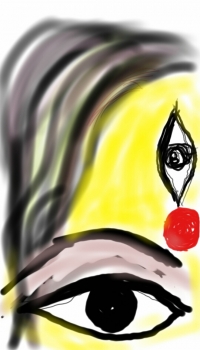The world today doesn't make sense, so why should I paint pictures that do?
That was Pablo Picasso speaking of his paintings
Yesterday, at the Readomania Talkfest, Avirook Sen said something very similar only he was looking at the whole thing from the other end of the telescope. While Picasso was painting chaotic life as he saw it, Sen felt writing is at its most expressive when the visual exists in our heads. When we see the full picture, with its whorls and dots, its colours garish or grey, see the crowd or the loneliness, the impression is indelible. So when one decides to put it into words, they pour out easily because one is simply describing what one can sees. No wonder the poet writes of what he saw, ‘They flash upon that inward eye, which is the bliss of solitude.’
Last evening, as the motley of writers and readers discussed this idea, my thoughts went back to when I used perform to Tagore’s songs at Santiniketan. The underlying principle of those mudras was the same---to interpret images inherent in the poet’s lyrics. Dance gestures and movements had to pictorially depict what the poet had seen in his ‘inner eye’ to inspire him to write as he did.
Pictures have always been my companions especially when travelling. Being an ‘army brat’, travel has been my middle name since birth. As I moved with my parents across this vast country whose very identity is its diversity, my inner eye has kept clicking pictures. Not just that. As children, to keep my brother and me engaged, my father often told us to draw and sketch whatever we saw while travelling. Somewhere, still around, are drawing books filled with childish scrawls of scenes outside train windows, of hills, lakes, bazaars, mules toting loads, smiling women in swinging ghagras and laughing children in chequered khos. The entire experience trained my internal camera to constantly snap images. It has grown into an involuntary response whenever I come across a striking visual, auditory or emotional impression.
Travelling has been a pleasurable activity and luckily I have been able to indulge in it beyond childhood; first as an army wife and second as a publishing executive. The thrill of going to a new place has always made me breathless with anticipation. The first impressions of any place---the countryside, the houses and buildings, the people, their dress, their language, the nuances of their everyday lives---- have never failed to excite me. Those images have retained forever. Funnily, the second visit to the same place has never had quite the same effect.
From my mind’s archival albums, if anyone asks me choose the most unforgettable one, I would instantly pick up my sojourn in Manipur in the year 1999. I had the benefit of spending a few months there when my husband was commanding a battalion of troops on insurgency duty near Imphal. A lasting impression that this beautiful sibling of the seven sisters leaves on a visitor is the dichotomy which is a veritable leitmotif. On one hand is Manipur’s natural beauty of rolling purple hills veiled in mist, carpets of green paddy fields, channels filled with unimaginable colours of lotus, sublime pools fringed by bamboos. Opposing it are speeding convoys of green-brown heavy-duty trucks bristling with soldiers, guns pointing at you, eyes raking you suspiciously, barked orders and rough handling of the Manipuris. As you wake up to glorious sunrises at 4 am, breathe deeply of the floral scents that waft in the air, are startled by the gaudy orchids that tease from nooks of trees, listen to songbirds orchestrated by humming bees in tropical flowers growing in thick bunches, you are assailed by the news of ambushes, shootings and raids by militants that ravage and ravish this magical land. Before you recover from the seduction of your senses, a gun is held to your head. You torn between what is real and what is reality. That is Manipur; a miracle shredded by Man’s viciousness.
And what of its people? Squeezed between militants encroaching on their daily lives and the overbearing pressure of the armed forces, it is the gun that holds sway. Yet, they attempt to eke out a life, as normal as possible in these abnormal times. In fact, there are generations in Manipur born and raised to adulthood who have known no other life than that threatened by the bullet. Sad, isn’t? But the schoolchildren trudging to school, giggling, chuckling and chasing each other down the road are far from sadness. That too, is Manipur; the silently resilient Manipur.
Pictures such as these leaped readily to my mind when I sat down to write my novel. They danced, sang and spoke to me and the words tumbled out. For me, it was some kind of catharsis to be able to express my pent-up emotions about the ways my experience of Manipur had affected me, nay--- changed me and my worldview. Unexpectedly, visuals emerged from my inner eye quite obediently as though they had been waiting to be summoned. Equally easy, it was to describe what my inner eye saw clearly as emotions leaped up in recollection from the recesses. They say that the debut novel is usually the most autobiographical. Actually in the case of my book, I was a helpless spectator as my pictures literally wrote themselves into its pages. To recall Picasso, life by itself painted pictures into my book.
For me, these pictures were old friends whom I had not met for a long time and they reminded me of who I had been. Still, time changes perspectives so the ‘I’ that exists today also got woven into the pictures in my book. It is like Henry Ward Beecher says, ‘Every artist dips his brush in his own soul, and paints his own nature into his pictures.’
All rights reserved @Sutapa Basu 2015
